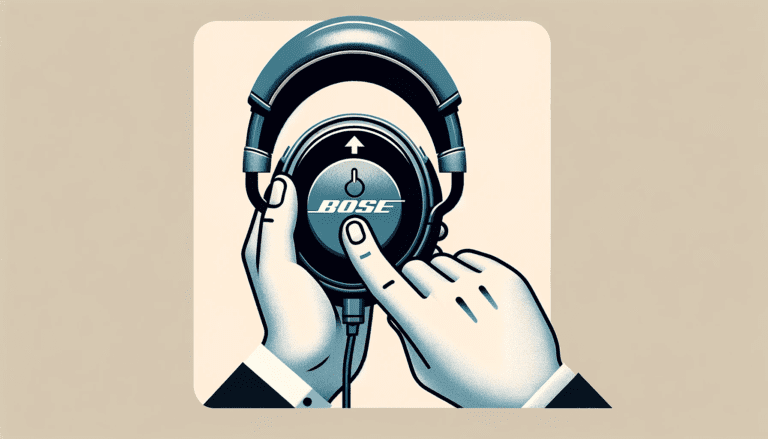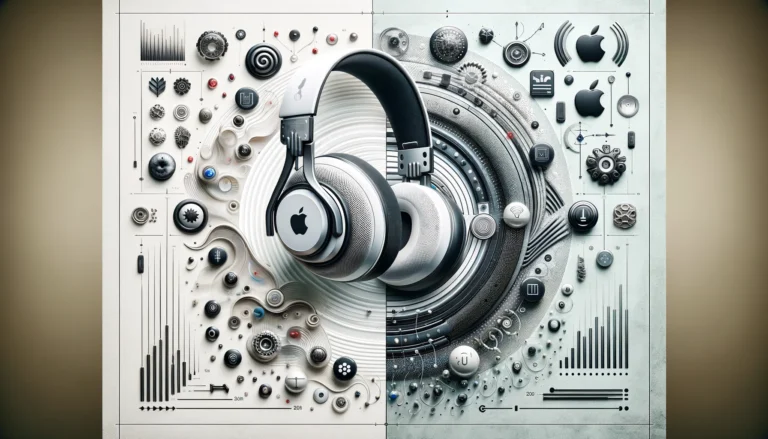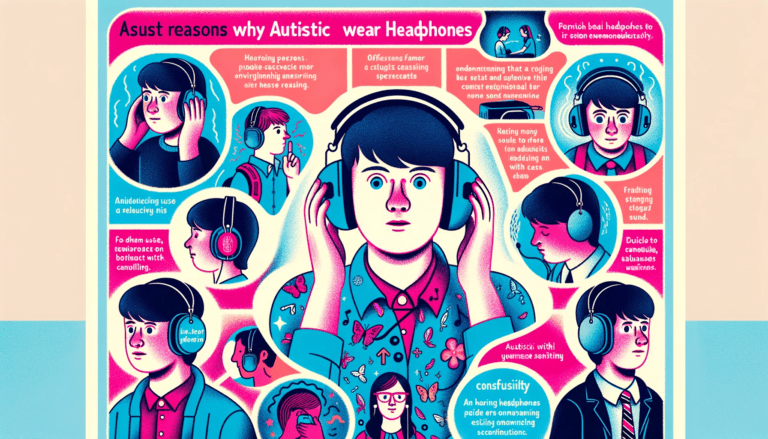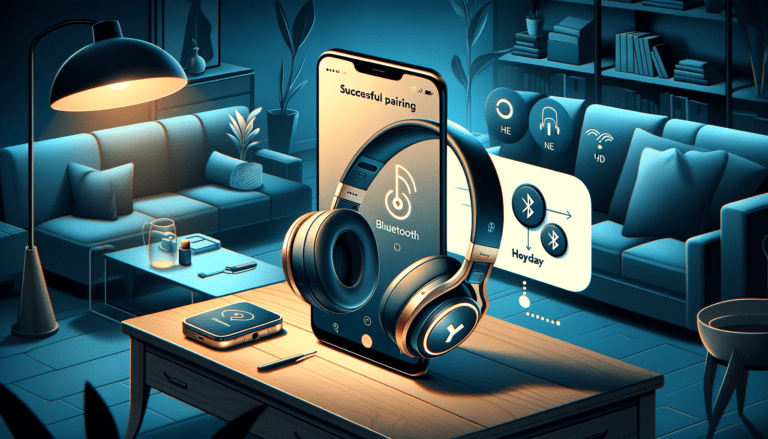Experiencing a headphone dent in your head can be a frustrating issue for avid music listeners and professionals alike. This unsightly problem, often caused by prolonged headphone usage, can lead to discomfort and even pain.
If you’ve ever noticed a persistent indent on flat hair on the top of your head after long listening sessions, you’re not alone. The good news is that preventing this peculiar issue is simpler than you might think.
In this article, we will guide you through practical steps to avoid the infamous headphone dent, ensuring your comfort without compromising your audio experience.
Whether you’re a dedicated audiophile, a professional in a sound-critical industry, or simply someone who enjoys immersing in music or podcasts throughout the day, this guide will equip you with the knowledge to protect yourself from unnecessary discomfort.
Say goodbye to headphone dents and hello to a more comfortable listening experience!
Key Takeaways
- Understanding the science behind headphone dent is crucial for identifying habits that increase risk and for selecting the right materials and designs to prevent it.
- Preventive measures include choosing headphones that fit well, wearing them correctly, and taking regular breaks to alleviate pressure on the head.
- Headphone maintenance is essential for hygiene and comfort, involving regular cleaning, timely replacement of ear pads, and proper storage to preserve their shape.
- Addressing headphone dent involves immediate actions such as adjusting the headphone placement and long-term strategies like using customized or professionally adjusted headphones.
- Beyond preventing headphone dent, it’s important to ensure overall ear health by understanding the impact of prolonged headphone use, protecting hearing, and undergoing regular check-ups.
Understanding the Causes of Headphone Dents
The Science Behind the Pressure
The term ‘headphone dent’ might evoke images of a literal indentation in one’s head, but in reality, the pressure exerted by headphones is far from causing any permanent damage or physical dent. The human skull and scalp is highly resilient, with a remarkable ability to recover from pressure-induced deformations. This resilience is due to the scalp’s elasticity and the cushioning provided by hair and skin.
When headphones are worn for extended periods, they apply a consistent force on the head. This force, while not enough to alter the skull’s shape, can lead to temporary marks or indentations in the hair or skin, which are often mistaken for a ‘headphone dent’. The sensation of pressure and the visible effects are typically temporary, disappearing shortly after the headphones are removed.
To understand the mechanics, consider the following data extracted from a study on material resistance:
| Infill Percentage | Pressure Required (N) | Deformation (%) |
|---|---|---|
| 50% | 140 | 30 |
| 70% | 230 | 30 |
This table illustrates how different materials respond to pressure, with higher infill percentages requiring more force to achieve the same level of deformation. While this data pertains to 3D printed materials, it serves as an analogy for the materials used in headphone cushions, which also exhibit varying degrees of resistance based on their composition.
Identifying High-Risk Habits
High-risk habits for developing a ‘headphone dent’ often stem from prolonged and improper use of headphones. Wearing headphones for extended periods without breaks can lead to the indentation and ear shape known as the headphone dent, as well as contribute to discomfort and pressure caused by potential skin irritation.
Key habits that increase the risk include:
- Using headphones with excessive clamping force
- Failing to adjust the headband for a proper fit
- Ignoring early signs of discomfort or pressure
It’s crucial to recognize these habits early on to prevent the formation of a headphone dent and ensure overall comfort during use. By being mindful of how and how long you use your headphones, you can mitigate the risk and enjoy your audio experience without the unwanted side effects.
The Role of Material and Design
The materials and design of headphones play a pivotal role in both comforts and the potential for causing a ‘headphone dent’. Headbands wear headphones that are too tight or inflexible can exert excessive pressure on the scalp, leading to discomfort and indentations. Conversely, headphones with a well-thought-out design that includes a flexible headband can distribute weight more evenly, reducing the risk of dents.
When considering the longevity and hygiene of headphones, the choice of materials is crucial. Materials that are easy to clean and resistant to wear and tear contribute to the overall hygiene and durability of the headphones. For example, headbands made from soft, pliable materials can adapt to the shape of the user’s head, offering a more comfortable fit and lessening the likelihood of pressure marks.
Here are some considerations for material and design in headphones:
- Durability: How well the materials withstand regular use.
- Comfort: The softness and flexibility of the headband.
- Hygiene: Resistance to sweat and ease of cleaning.
- Adjustability: The ability to modify the fit to suit individual head shapes.
Preventive Measures for Headphone Users
Choosing the Right Headphones
Selecting the ideal headphones is crucial for both comfort and auditory health. Comfort should be your top priority when shopping for headphones, as the right fit can prevent the formation of pressure points that lead to the dreaded ‘headphone dent.’ It’s essential to consider the clamping force, cushioning, and adjustability of the headband to ensure a snug yet gentle fit.
When considering the purchase of headphones, it’s also important to think about their longevity and sound quality. Features such as active noise canceling (ANC) can enhance your listening experience by blocking out unwanted noise, allowing you to focus or relax without cranking up the volume to potentially harmful levels. Battery life is another key factor, especially for wireless models, to ensure your headphones can keep up with your lifestyle without frequent recharging.
Here are some factors to consider when choosing headphones:
- Fit and comfort: Look for adjustable headbands and soft ear cushions.
- Sound quality: Prioritize clear audio with balanced bass and treble.
- Noise cancellation: Active noise canceling (ANC) helps isolate you from external sounds.
- Battery life: For wireless headphones, longer battery life means less frequent charging.
- Durability: Opt for models known for their longevity and robust construction.
Proper Wearing Headphones Techniques
To avoid the dreaded ‘headphone dent’, it’s crucial to wear your headphones correctly. Adjusting the headband to fit snugly but not put too much pressure too tightly can prevent unnecessary pressure on the scalp. It’s also important to position the headphones and change the ear cups to evenly distribute weight around the ears rather than concentrating it in one area.
Another tip is to rotate the headphones periodically during extended use. This simple action can help to redistribute pressure and minimize the risk of developing a dent. Additionally, consider the hairstyle you choose when wearing headphones. As suggested by CitizenSide, braiding or twisting your hair before putting on the headset can be an effective method to prevent hair dents.
Lastly, be mindful of the duration you wear your headphones. Taking regular breaks not only helps in preventing dents but also contributes to overall ear health. Here’s a quick checklist to ensure proper wearing techniques:
- Adjust the headband for a comfortable fit
- Position ear cups to distribute weight evenly
- Rotate headphones periodically
- Opt for protective hairstyles
- Take regular breaks to rest your scalp
Adjustment and Breaks: Balancing Comfort and Safety
To maintain both comfort and safety while using headphones, it’s crucial to find the right balance between proper fit and regular breaks. Adjusting the fit of your headphones is essential to avoid the dreaded ‘headphone dent’ and ensure a comfortable experience. This involves not only positioning the ear cups snugly over your ears but also ensuring that the headband is not too tight, which can lead to discomfort and even headaches.
Taking regular breaks is equally important. It allows your head and ears to rest, reducing the risk of developing pressure points. Here’s a simple guideline to follow when taking breaks:
- Every hour, remove your headphones for at least 5 to 10 minutes.
- During breaks, perform light stretches or walk around to improve circulation.
- Adjust the tightness and position of your headphones each time you put them back on.
Remember, the goal is to create a listening experience that is both enjoyable and mindful of your health. By incorporating breaks and making adjustments, you can protect yourself from the negative effects of prolonged headphone use.
Maintaining Your Headphones for Hygiene and Comfort
Cleaning Protocols for Headphones
Maintaining the cleanliness of your headphones is crucial for both hygiene and preserving their functionality. Regular cleaning can prevent the build-up of oils, dust, and skin particles that can degrade the materials and affect sound quality. Start by removing your headphones’ ear pads, if possible, to access all surfaces that come into contact with your skin.
To clean your headphones effectively, follow these steps:
- Wet a cloth with a soapy solution and wring it out to prevent water leakage.
- Use the damp cloth to gently wipe the ear pads and other surfaces.
- Ensure that any compartments or ports are sealed or closed tightly to prevent liquid from entering the system.
- After cleaning, dry the headphones thoroughly with a clean, soft cloth before using them again.
Avoid submerging your headphones in water, especially beyond 1.5 meters or for more than 30 minutes. Also, refrain from exposing them to high-pressure water, as this can damage the water and dust resistant features. If your headphones have been immersed in water or if the microphone or speaker is wet, ensure they are completely dry to avoid muffled sound during use.
When to Replace Ear Pads or Headphones
Knowing when to replace your ear pads or headphones is crucial for maintaining both hygiene and comfort. Over time, ear pads can accumulate sweat, oils, and dirt, which not only affects their comfort but can also lead to skin irritation or infections. Regular inspection of your ear pads for signs of wear and tear is essential. If you notice any cracking, flaking, or a significant decrease in padding, it’s time for a replacement.
Headphones themselves also have a lifespan. While they generally last longer than ear pads, factors such as sound quality degradation or physical damage are clear indicators that it’s time to invest in a new pair. Here’s a simple checklist to help you decide when to replace your ear pads or headphones:
- Check ear pads for visible damage or discomfort during wear.
- Assess the sound quality periodically; diminished sound may suggest it’s time for new headphones.
- Consider the hygiene aspect; if cleaning doesn’t remove all residues or odors, replace the ear pads.
- Be mindful of the manufacturer’s recommended lifespan for your specific model.
For a thorough clean, wash off your earphones with soapy water a full few hours several times each year. Make sure your earphone pads are totally dry before replacing them. This not only extends the life of your ear pads but also ensures that you’re not reintroducing moisture that can damage the headphones or affect your skin.
Storage Tips to Preserve Headphone Shape
Proper storage of your headphones can significantly extend their lifespan and maintain their original shape throughout. Avoid exposing your headphones to extreme temperatures or high moisture, as these conditions can deform the materials and lead to a loss of shape. Instead, store them in a cool, dry place away from direct sunlight.
When not in use, it’s best to hang your headphones on a dedicated stand or lay them flat in their case. This prevents unnecessary stress on the headband and ear cups, which can cause the dreaded ‘headphone dent’. If you’re using earbuds with silicone tip attachments, remember to allow them to return to shape after use before storing them to avoid permanent deformation.
Here are some additional tips to keep in mind:
- Use a headphone case or pouch to protect against dust and scratches.
- If your headphones are foldable, ensure they are properly collapsed before storing.
- Avoid wrapping the cord tightly around the device, as this can damage the wires over time.
Addressing the Headphone Dent: Remedies and Solutions
Immediate Actions to Alleviate Discomfort
If you’re experiencing discomfort from a headphone dent, taking immediate action can help alleviate the issue. Gently massaging the affected area can help to relax the skin and muscles, easing any numbness caused by pressure or strain. It’s important to be gentle to avoid further irritation.
For those who notice indentations after a prolonged period of headphone use, consider the following steps:
- Switch to headphones that go over the back of your head to distribute pressure more evenly.
- Take short breaks every hour to give your head and ears a rest.
- Adjust the headband to ensure it’s not too tight, as this can exacerbate the dent.
Remember, these are temporary solutions. For persistent issues, consult a professional for advice tailored to your specific situation.
Long-Term Strategies for Dent Prevention
To prevent the dreaded ‘headphone dent’ in the long run, it’s essential to adopt a holistic approach that includes both the choice of headphones and the way they are used. Regularly rotating headphones can distribute pressure more evenly over time, reducing the risk of developing a persistent headset dent. Lightweight headphones are particularly beneficial, as they exert less pressure on the hair and scalp.
In addition to choosing the right gear, maintaining a consistent hair care routine is crucial. For those with long hair, it’s advisable to avoid wearing tight headphones for long periods, especially if the hair is fine to medium in texture. This can help keep ‘headphone hair’ to a minimum and prevent the formation of dents.
Here are some additional tips for long-term dent prevention:
- Use over-ear headphones with a wide headband to spread out the pressure.
- Opt for headphones with adjustable bands to find the perfect fit without excessive tightness.
- Take breaks every hour to give your hair and scalp a rest from the headphones.
- Consider using hair-friendly accessories, such as cushioned headbands, to provide an extra layer of protection.
Professional Solutions and Adjustments
When addressing the various rid of headphone back dent, professional solutions can offer a tailored approach to ensure both comfort and proper fit. Consulting with a specialist can provide insights into the best adjustments for your specific head shape and headphone model. These experts may suggest modifications such as altering the headphone band headband tension or adding padding in strategic areas.
For those seeking a more holistic approach, treatments like Advanced Light Force (ALF) therapy have emerged. ALF is a non-traditional method that not only addresses the dent but also considers the overall cranial health. It’s important to verify the qualifications of any professional and understand the services covered by insurance before proceeding.
Here are some practical steps you can take after consulting with a professional:
- Confirm the specialist’s credentials and areas of expertise.
- Discuss potential adjustments specific to your headphone use and head shape.
- Inquire about insurance coverage for any recommended treatments or modifications.
Conclusion
In conclusion, maintaining headphone hygiene and avoiding the dreaded ‘headphone dent’ requires a combination of proper care, regular cleaning, and mindful usage.
By following the tips outlined in this article, you can ensure that your headphones remain in top condition, free from damage, and hygienic for daily use.
Remember to handle your headphones gently, clean them with appropriate materials, and give your head a break from prolonged wear to prevent any indentations or discomfort.
With these practices in place, you can enjoy your audio experience without compromising on comfort or hygiene.
Frequently Asked Questions
What causes the ‘headphone dent’ and how can I prevent it?
The ‘headphone dent’ is often caused by prolonged pressure from tight-fitting headphones. To prevent it, choose headphones with a comfortable fit, wear them properly, and take regular breaks to relieve pressure.
Can certain materials or designs of headphones reduce the risk of getting a ‘headphone dent’?
Yes, headphones made with softer, more pliable materials and those with adjustable bands can distribute pressure more evenly and reduce the risk of a ‘headphone dent’.
How often should I clean my headphones to maintain hygiene?
It’s recommended to clean your headphones regularly, depending on usage. Wipe them down with a dry cloth after each use and perform a deeper clean with appropriate cleaners weekly or bi-weekly.
When should I consider replacing my ear pads or headphones?
Replace ear pads when they show signs of wear, such as flaking or loss of shape. Consider replacing headphones if they no longer fit comfortably over outer ears or if sound quality diminishes.
What immediate actions can I take if I notice a ‘headphone dent’?
If you notice a ‘headphone dent’, take a break from wearing your headphones occasionally, gently massage the affected area, and consider using a warm compress to help restore your skin’s natural shape.
How can prolonged headphone use affect my ear health, and what precautions should I take?
Prolonged headphone use can lead to hearing damage if volumes are too high. To protect your ears, keep the volume in ear headphones at a safe level, take regular breaks, and have periodic hearing check-ups.






